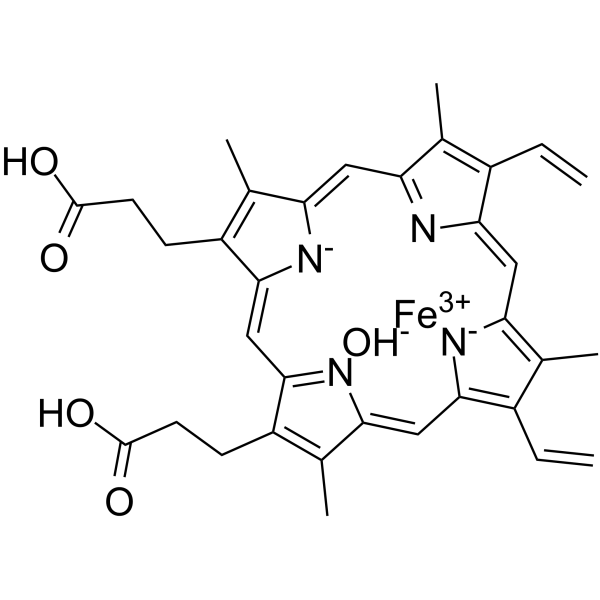
Hematin
CAS No. 15489-90-4
Hematin( Ferrihemate | Ferriheme | Ferriheme hydroxide | Ferrihemic acid )
Catalog No. M27159 CAS No. 15489-90-4
Hematin is an iron-containing porphyrin. It is used for testing in vitro activities of the Rx-01 oxazolidinones against hospital and community pathogens.
Purity : >98% (HPLC)
 COA
COA
 Datasheet
Datasheet
 HNMR
HNMR
 HPLC
HPLC
 MSDS
MSDS
 Handing Instructions
Handing Instructions
| Size | Price / USD | Stock | Quantity |
| 100MG | 38 | In Stock |


|
| 200MG | Get Quote | In Stock |


|
| 500MG | Get Quote | In Stock |


|
| 1G | Get Quote | In Stock |


|
Biological Information
-
Product NameHematin
-
NoteResearch use only, not for human use.
-
Brief DescriptionHematin is an iron-containing porphyrin. It is used for testing in vitro activities of the Rx-01 oxazolidinones against hospital and community pathogens.
-
DescriptionHematin is an iron-containing porphyrin. It is used for testing in vitro activities of the Rx-01 oxazolidinones against hospital and community pathogens.
-
In VitroHematin (0.01 mg/ml) inhibits the clotting of bovine fibrinogen (1.3 to 2.6 mg/ml) by bovine thrombin (0.12 U/ml) and inhibits the hydrolysis of a synthetic substrate by human thrombin.Hematin (0.035 mg/ml) reduces VIII:C activity from 0.88 to 0.40 U/ml.Hematin (0.05 mg/ml) inhibits the activation of VIII:C by thrombin (0.04 U/ml).Hematin (0.09 mg/ml) inhibits the hydrolysis of a synthetic substrate by plasmin.
-
In VivoHematin (i.v.; single injection) suppressed porphyrin production in SD rat (weighing 160-205 g).
-
SynonymsFerrihemate | Ferriheme | Ferriheme hydroxide | Ferrihemic acid
-
PathwayOthers
-
TargetOther Targets
-
RecptorAntifection| VEGFR
-
Research Area——
-
Indication——
Chemical Information
-
CAS Number15489-90-4
-
Formula Weight633.5
-
Molecular FormulaC34H33FeN4O5
-
Purity>98% (HPLC)
-
SolubilityIn Vitro:?DMSO : 1.43 mg/mL (2.26 mM)
-
SMILESCC1=C(C=C2C(C)=C(C=C)C3=[N]2[Fe]45(O)N6C(C(C)=C(C=C)C6=C7)=C3)N4C(C=C8[N]5=C7C(C)=C8CCC(O)=O)=C1CCC(O)=O
-
Chemical Name——
Shipping & Storage Information
-
Storage(-20℃)
-
ShippingWith Ice Pack
-
Stability≥ 2 years
Reference
1.Antifungal activity of lariciresinol derived from Sambucus williamsii and their membrane-active mechanisms in Candida albicans.Biochem Biophys Res Commun. 2011 Jul 8;410(3):489-93.
molnova catalog



related products
-
α-Cyclodextrin
Alfadex is a soluble fiber derived from corn and has beneficial effects on weight management in obese individuals with type 2 diabetes.
-
Decursitin D
Decursitin D is a natural product from the roots of Peucedanum decursivum.
-
GNF4877
GNF4877 is a potent DYRK1A and GSK3β inhibitor (IC50s: 6?nM and 16?nM).



 Cart
Cart
 sales@molnova.com
sales@molnova.com


